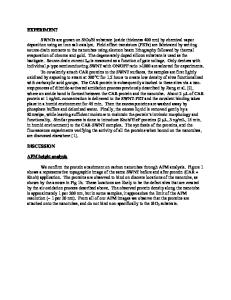N 2 Detection by the Carbon nanotubes Mat and Bundle
- PDF / 507,450 Bytes
- 7 Pages / 612 x 792 pts (letter) Page_size
- 94 Downloads / 442 Views
0900-O09-37.1
N2 Detection by the Carbon nanotubes Mat and Bundle
C.S. Huang*, B.R. Huang, Y.H. Jang, M.S. Tsai, J.Y. Ya, C.A. Chien Department and Institute of Electronic Engineering, National Yunlin University of Science and Technology, Taiwan, 64002 [email protected]
Abstract
Carbon nanotubes (CNTs) were synthesized by thermal chemical vapor deposition (thermal
CVD) on n-type Si (100) at 700 ℃ under C2H2 gas flow ratio of 30 sccm. by RF sputtering system with RF power 150 W.
Fe catalysts were pre-deposited
Two kinds of as-grown CNTs were used to detect N2: the
vertically oriented carbon nanotubes (CNTs) mat and horizontally oriented CNTs bundle. Two-terminal electrical measurements were performed at room temperature of 25 ℃.
The electrical resistance of
CNTs mat or bundle was found to increase when exposed to N2 environment, and to return back after the N2 pumping, respectively. response and recovery time.
However, the CNTs bundle had better sensitivity and possessed faster
This could be ascribed to that the CNTs bundle, with more effective grooves
on the surface, provided more lower binding-force sites to absorb N2 molecules than the CNTs mat dose, which prominently had interstitial sites. Keywords: carbon nanotubes, bundle, gaseous sensor.
1. Introduction Since their discovery in 1991 [1], carbon nanotubes (CNTs) have been the most promising material due to their unique structure and properties. These unique properties of CNTs make them as field emission devices [2], tips for scanning probe microscopes [3], hydrogen storage [4], quantum wires [5], random access memory [6], and gas sensor [7-9]. Existing electrical sensor materials include semiconducting metal oxides [10–12], silicon devices [13, 14], organic materials [15, 16], and carbon black–polymer composites [17]. Although traditional gas sensors made by using semiconducting oxides are inexpensive, safe and sensitive, they have to be operated at high temperatures to enhance chemical reactivity between the material and the gas molecule. Semiconducting metal oxides have been widely used for NO2 and NH3 detection [7–9]. The major weakness of high operation temperature makes traditional gas sensors have a limit for future application. Due to the discovery of nanostructural materials, such as carbon nanotubes (CNTs)[18], nanoparticle[19,20], nanobelt[21,22], titania nanotubes[23-25] and nanowire[26-27], a whole new era of gas sensors began . The high specific surface area, small size, hollow geometry,
0900-O09-37.2
excellent mechanical properties, predictable electricity, stable chemical inertness of carbon nanotubes (CNTs) makes them become the most promising material for the applications of gas sensors with good sensitivity and rapid response time . According to the electron-transmission mechanism on the surface of CNTs, the detected gas can be classified into reducing and oxidizing gaseous species. Being exposed to reducing gaseous species (such as NH3[28], CO2[18,29] , N2 [30] and ethanol[31] etc.) the electrical resistance of CNTs wa
Data Loading...











